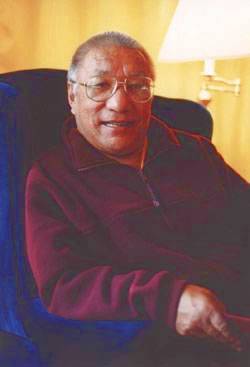| [10]

Venerable Khenpo Tsultrim Gyatso Rinpoche
Shentong – An Introduction
Translated by Ari Goldfield
“I prostrate to the one
Who teaches that whatever is dependently arisen
Is not permanent, is not extinct,
Does not come, does not go,
And is neither one thing nor different things.
I prostrate to the perfect Buddha, the supreme of all who speak,
Who completely dissolves all fabrications and teaches peace.”
In: The Sun of Wisdom. Teachings on the Noble Nagarjuna’s “Fundamental Wisdom of the Middle Way,” translated & edited by Ari Goldfield, Shambhala, Boston & London, 2003, page 1.
Before listening to Lord Buddha’s teachings, I want to ask you to give rise to supreme bodhicitta. Supreme bodhicitta is generated and increased by first thinking of one’s father and mother in this life and then extending the gratitude and love one feels for them to all sentient beings, even to one’s enemies. We want to attain the state of complete and perfect enlightenment for their sake. We know that in order to be able to benefit all sentient beings, we need to listen to, reflect, and meditate upon the genuine Dharma teachings with all the enthusiasm we can muster in our hearts. Please give rise to supreme bodhicitta when you listen attentively.
We think of our parents first, because the fact that we are able to practice the Dharma in this lifetime is due to the immense kindness they have shown us. We think of our enemies, too, because they are the ones who give us the exceptional opportunity to practice patience when they are unkind and hurt us. Furthermore, there is not a single enemy who was not our caring father or mother at one time in the past, so that is why we remember them with gratitude. We think of the nature of the minds of the people we are associated with - our friends, our enemies, and all sentient beings. We know that every single sentient being’s nature of mind is clear light, the enlightened heart that is the Buddha nature. Since everyone has Buddha nature, we can be sure that we will benefit others immensely. Just as the nature of our own mind is clear light, the nature of our parents’ minds is also clear light. Likewise, the mind’s nature of all our friends and enemies is clear light. The nature of mind of every single sentient being is luminosity, clear light.
In the nature of the mind there is no stain. There is not the slightest conceptual fabrication in the mind’s true nature, and that is why mind is known as “empty of other,” gzhan-stong. Since the ineffable nature of mind of every single sentient being is clear light and since the essence of this clear light is free of the slightest stain that arises due to dualistic fixations and mental constructs, one can develop the vast understanding that the one who apprehends (the subject) and what is apprehended (objects) have the same essence. Knowing this enables practitioners to develop inconceivable compassion and a pure vision of reality. Knowing that relative apprehensions are “self-empty,” rang-stong, and knowing that mind’s true nature is “empty of other,” gzhan-stong, a sincere practitioner no longer slips into garments that are extreme views about creation or cessation. Seeing that all phenomena that can be apprehended are empty of an own essence, one no longer clings to the extreme of permanence. Seeing that mind’s true nature is replete with many invaluable qualities that manifest spontaneously and naturally, one no longer clings to the extreme of nihilism or cessation. Since all relative phenomena that appear are empty of a self, it is conclusive that the mind that apprehends and conceives relative appearances is also empty of a self. Since mind’s true nature transcends what can be accomplished, affirmed, or refuted, then what one thinks must be accomplished and what one thinks must be abandoned are always and already pure and free.
It is taught that if one overcomes beliefs in a truly existing self, in truly existing mental afflictions, in truly existing difficulties, in truly existing suffering, and so forth, then one will have peace. But since everything is empty of an own essence already, then why worry about momentary mental constructs regarding things that need to be abandoned or not abandoned? Nobody has ever seen nor was able to prove that thoughts about abandoning and not abandoning arise and cease, i.e., come and go. Nobody has ever perceived these thoughts and never will, because their true nature is emptiness. Doubts as to whether thoughts are born and cease again cannot be said to be the results of either bondage or of liberation. However, momentary perceptions and apprehensions are solidified through resulting temporary conceptions by insisting that what was apprehended denotes either bondage or liberation. Just like thoughts that arise in a dream, ideas about bondage and liberation are merely imagined, kun-brtags. A few English translations of kun-tu-brtags-pa (kun-brtags) are “imputed, imaginary, conceptualized, conceptual.” Kun-tu-brtags-pa’i-ma-rig-pa means “conceptual ignorance, non-recognition of intrinsic awareness resulting in conceptual imputation.”
Everyone - even those beings who are entangled and bound in mental constructs - lacks an essence. Doubts that arise in a practitioner’s mind and that keep him and her in bondage can never be found to arise or cease. Thoughts about bondage depend upon thoughts about liberation and vice versa. Concepts merely arise in the mind and are ever dependent upon each other, gzhan-dbang. A few English translations of gzhan-dbang are “dependent conditionality, conditioned phenomena, other powered, controlled by externals, the dependency nature, relative dependence, external influence.”
Let clinging to all constructed limitations subside into the unborn expanse of dharmadhatu – sprös-pa-mtha'-dag-chös-dbyings-su-nub-pa.
Since this life is appearance-emptiness and like a reflection of the moon on a pond, past and future lives are also appearance-emptiness and like reflections of moons on ponds. Feeling happy and feeling sad are just like thoughts that arise in a dream. If we know this well, then we will have realized the profound view, which is wisdom devoid of all mental fabrications - sprös-pa-thams-cäd-dang-bräl-ba'i-ye-shes.
Just like every appearance in the relative world is empty of itself, the clear light is empty of “adventitious, fleeting stains,” glo-bur-gyi-dri-ma-med-pa . In other words, the clear light is “empty of adventitious, fleeting thoughts,” glo-bur-gyi-rnam-rtog-med-pa. Proponents of the empty-of-other view are masters and disciples of what has come to be known as gzhän-stong-dbu-ma, the “Shentong ‘Great’ Madhyamika School.”
The lineage of masters of the Shentong School that focuses on emptiness indivisible from luminosity, clear light, include Yumo Mikyo Dorje, Tukje Tsondru, Dolpopa Sherab Gyaltsen, and Taranatha.
Since the mind’s essence is primordially pure and free of stains that are other than the mind’s essence, mind’s true nature is referred to as “transcendent perfection of authentic purity.” Since the mind’s essence is other than the self that one believes in and clings to and since the mind’s essence is other than non-self or selflessness discovered through inference and deduction, mind’s true nature is referred to as “the genuine self.” But how can stains of erroneous notions about it conceal mind’s true nature? Mind’s true nature is beyond the self one thinks one perceives and then imputes to be real and it is beyond the notion of selflessness one thinks one has discovered through logical reasoning. Mind’s true nature is called “genuine self” since it is beyond any assumptions of both a self as well as non-self or selflessness.
Samsara and nirvana are conceptualised and imputed in reciprocal dependence upon each other and therefore neither the one or the other is independent, i.e., samsara and nirvana depend upon each other. When a practitioner sees the equality and undivided nature of samsara and nirvana by having realized that the essence of both is emptiness, then he or she has realized transcendent perfection of real permanence. Happiness and suffering are conceptualised and imputed in reciprocal dependence upon each other and therefore neither the one or the other is independent, i.e., happiness and suffering depend upon each other. When a practitioner sees the equality and undivided nature of happiness and suffering by having realized that the essence of both is emptiness, then he or she has realized transcendent perfection of bliss. Then the unmistaken and transcendent self, unchanging permanence, and pure bliss have been “fully established,” yongs-grub.
This was a brief explanation of the way relative appearances and experiences are empty of self, rang-stong, and the way true reality is empty of other, gzhan-stong.
May all of you realize the true nature of mind that is steadfast, peace, unchanging, and constant and through that be of great benefit to the limitless number of sentient beings.
Thank you very much.

May the life of the Glorious Lama remain steadfast and firm.
May peace and happiness fully arise for beings as limitless (in number) as space (is vast in its extent).
Having accumulated merit and purified negativities, may I and all living beings without exception
swiftly establish the levels and grounds of Buddhahood.

Instructions presented at the Vajra Vidya Thrangu House in Oxford, 2000, transcribed and edited by Gaby Hollmann, responsible for any mistakes.

|